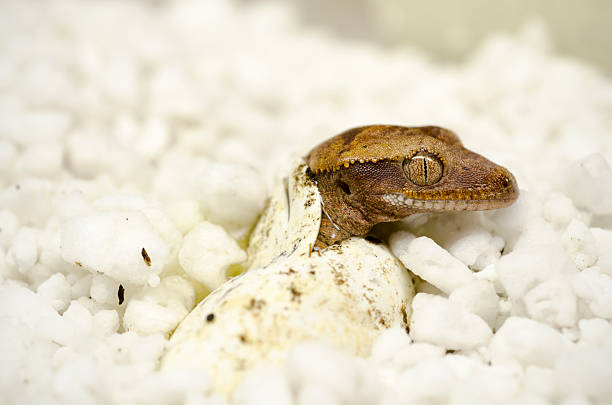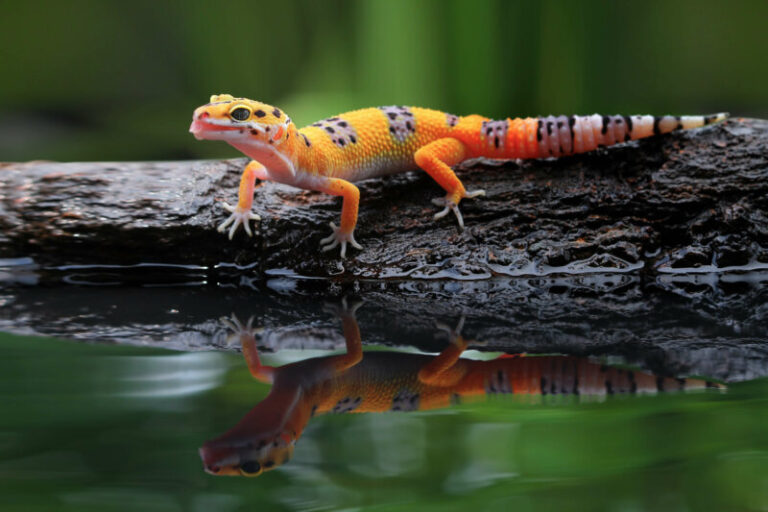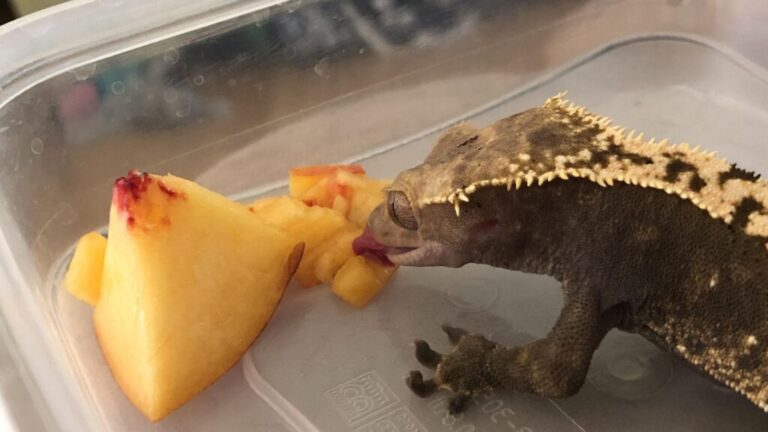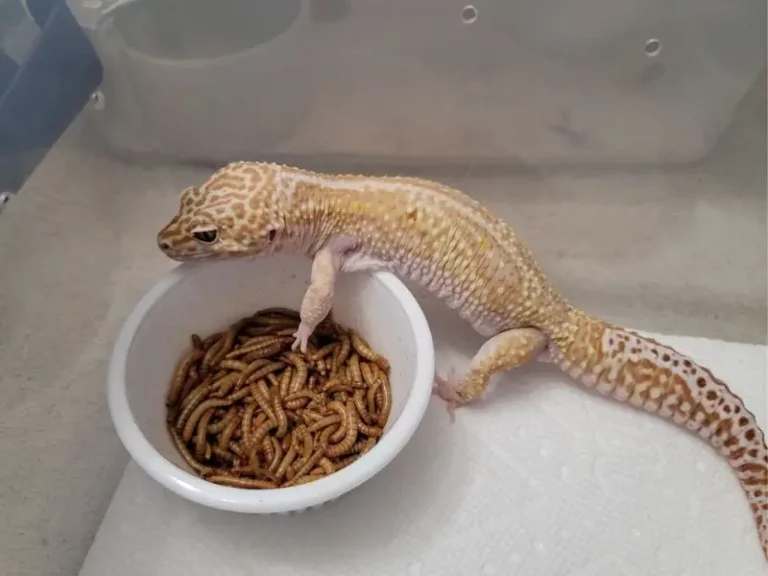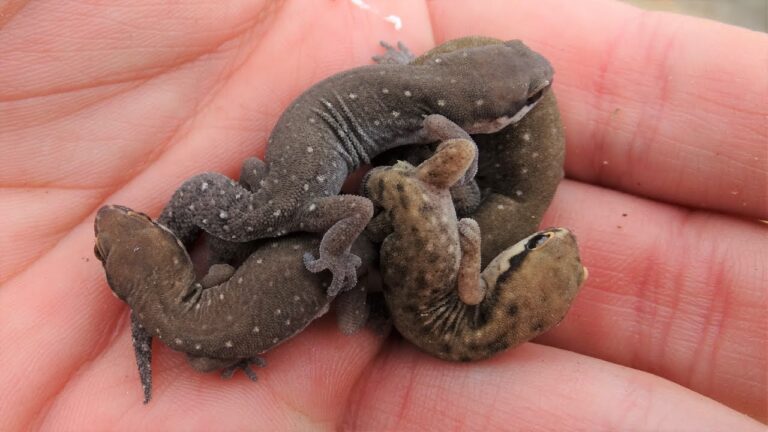Unlocking the Mystery: Do Geckos Lay Eggs
Have you ever wondered if geckos lay eggs? I was curious too, so I decided to find out!
A warm, tropical forest at night, full of fascinating creatures. I ventured into this world, armed with a flashlight and a thirst for knowledge.
As I followed clues and listened to legends, I couldn’t help but wonder about gecko babies. Do they come from eggs, like bird eggs you might find in a nest? Or do they hatch from their mother like some other animals?
The answer is Yes,, Geckos reproduce by laying eggs. Female ones can carry their eggs inside them for extended periods, sometimes even for several years, before eventually laying them. It is not just interesting but also tells us about geckos’ history on Earth.
So, let’s get started!
How Do Geckos Lay Eggs?
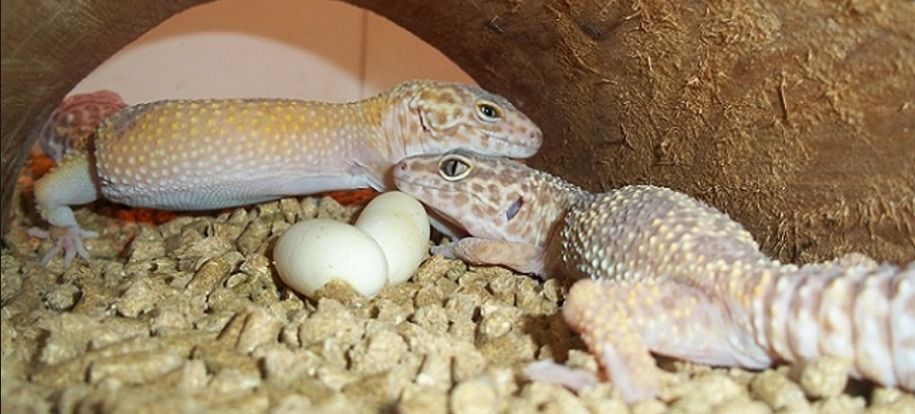
Timing and Maturity: Gecko reproduction begins when these creatures reach sexual maturity and attain their full adult weight. Males can start breeding as early as one year old, while females usually wait until they are two years old. This age difference ensures the safety of egg laying without interfering with overall growth.
Seasonal Reproduction: they typically mate during late winter and early spring, aligning with seasonal changes. The process involves a precise courtship ritual where the male initiates mating by biting the female’s neck.
Egg Development: After mating, females carry developing eggs within their bodies until they are ready to be laid. They take on the role of diligent parents by digging a hole to bury the eggs securely, protecting them from potential predators.
Unique Egg Shells: Gecko eggs have soft shells, allowing embryos to continue growing outside the mother’s body. Breeders often incubate these eggs, with temperature playing a role in determining the gender of the baby geckos.
Hatching and Early Life: Around 6 to 12 weeks after being laid, eggs begin to shrink in preparation for hatching. The baby uses their teeth to pierce the eggshells and emerge into the world. They measure around 3 to 4 inches and initially feed on their shed skin.
Initial Requirements: During the first few weeks of life, baby geckos have minimal requirements, including shelter, access to water, and a diet rich in live insects, which provide essential nutrients.
Stress-Free Development: Creating a stress-free environment during this stage is crucial for optimal growth and development of baby creature.
Why Female Geckos Lay Eggs Without Mating?
In general, once a female gecko reaches sexual maturity, she initiates a natural physiological process known as ovulation. This process prompts the gecko to produce eggs on a regular basis, and she will either lay them or reabsorb them into her body. Also, if she doesn’t find a suitable mate partner.
More factors like
Environmental Triggers: Parthenogenesis can be triggered by specific environmental conditions, particularly in captivity. Factors such as temperature and light cycles can influence this process, allowing females to reproduce independently when isolated from males.
Genetic Cloning: Parthenogenesis leads to offspring that are genetic clones of the mother. These offspring inherit identical genetic material, offering short-term advantages if the mother’s traits are well-suited to the current environment.
Evolutionary Relic: The occurrence of parthenogenesis in leopard reptiles may be a relic from their evolutionary history, persisting as an occasional method of reproduction over time.
How To Tell Gecko Is Pregnant?
Female reptiles typically reach sexual maturity between 18 to 24 months. If you’re uncertain about your pet’s age, you can refer to our guide on determining their age.
During this phase of their life, female reptiles begin ovulating, a natural process that may lead to pregnancy, even without mating. Understanding the signs of pregnancy is crucial for providing proper care and nutrition during this period.
The most common indicators of pregnancy include:
Swollen Abdomen: The most conspicuous sign of pregnancy in a female is a swollen abdomen. This swelling is distinct from regular weight gain, as it tends to be symmetrical. Reptiles typically lay clutches of eggs at a time, and the swelling primarily occurs in their abdominal region. To confirm pregnancy, gently press the belly to feel for the eggs, which will resemble firm muscles or two small lumps beneath the skin.
Lack of Appetite: As pregnancy progresses, your pet may exhibit a reduced appetite or even refuse to eat altogether. This change in behavior occurs because the growing eggs occupy space within their stomach and digestive tract. Despite the decreased appetite, continue providing regular meals and water, supplementing with calcium and multivitamins to ensure adequate nutrition.
Lethargy: Lethargy is another symptom of pregnancy, resulting from decreased energy due to reduced food intake during egg development. The rapid growth of eggs places additional demands on their small bodies. Furthermore, a protective instinct kicks in, causing them to move more slowly and remain close to their hiding spot.
Behavioral Changes: Pregnancy triggers heightened alertness, leading to potential changes in behavior. Your pet may exhibit signs of aggression or stress, such as running away, hiding, biting, chirping, or even dropping their tail. To minimize stress, avoid handling your pet during this time and create a quiet and calm environment in the enclosure. Providing a nesting box can also offer comfort and a safe place for them to hide and protect their eggs.
How To Tell Gecko Is About To Lay Eggs?
Pregnancy in these reptiles typically spans a duration of 21 to 28 days, followed by an additional 35 to 89 days until the eggs hatch.
If the eggs prove to be infertile, they will eventually wither and develop mold. Hence, it’s crucial to promptly remove any infertile eggs from the enclosure as soon as they are discovered.
Recognizing the signs that your pet is about to lay her eggs is essential for ensuring a smooth process. These signs include:
- Your pet may engage in extensive digging behavior to create a suitable nesting spot.
- Observe muscle contractions in the hind limbs, which are indicative of the impending egg-laying process.
- You may notice the eggs on the underside of your pet’s body, visible through her skin.
- A decreased appetite is common during this period.
- Clear fluid may leak from the cloaca, a sign that the egg-laying process is approaching.
- Your pet might become more restless as she prepares to lay her eggs.
Also, Recognizing these signs is a strong indicator that your gecko will likely lay her eggs within a matter of days. Continue to monitor her closely to ensure there are no complications, such as egg binding.
If you are certain that your gecko has not mated and the eggs are infertile, it’s important to remove them promptly to prevent mold formation. For fertile eggs, proper incubation is essential.
In addition, Place them in a plastic container filled with peat moss to maintain moisture and keep them at a warm temperature. Since the eggs are small, the container need not be very large. When kept at an appropriate temperature, they will hatch within a matter of weeks.
Where Do Geckos Lay Their Eggs?
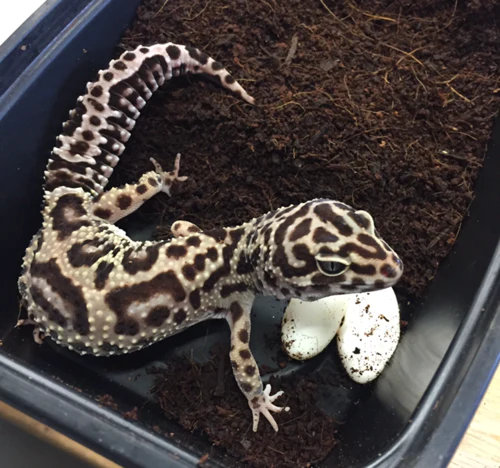
In the wild, female reptiles choose safe spots, like under tree bark or rocks, to lay their eggs. But when it comes to looking after their babies, reptiles aren’t very involved.
After they carefully protect their eggs, they usually lay them and move on with their lives, only returning occasionally, sometimes even to eat their own eggs.
While they might not be the most attentive parents, they do tolerate their young for a while, offering some protection.
Interestingly, these reptiles sometimes find comfy spots in human homes to lay their eggs. Places like basements or cabinets under sinks are popular because they are often damp, and there are plenty of insects around for them to eat.
Before laying eggs, female reptiles search for a safe spot where predators are unlikely to find them. Hidden places like behind bookshelves are perfect because there’s usually not much activity there.
What are the key essentials for successful gecko breeding?
Breeding reptiles and caring for them requires specific essentials to ensure success and provide optimal care to egg-laying females. Here’s a checklist of what breeders need:
Male Enclosure: A 10-gallon tank is suitable for housing a male reptile.
Female Enclosure: Female reptiles need a slightly larger space, typically a 20-30 gallon tank.
Heat Mat: Use a heat mat to maintain the appropriate temperature in their habitats.
Egg-Laying and Hide Box: Females require an egg-laying or hide box in their tank. Natural options are available, such as those found on Amazon.
When introducing a male to the female enclosure, it’s essential to monitor their interaction to prevent potential aggression. Safety for the females is paramount, and any risk of injury from the male should be minimized.
Additionally, once successful mating occurs, check the egg-laying box periodically after a few weeks to look for eggs. Promptly collect the eggs to prevent them from drying out. During this process, handle the eggs carefully and avoid turning them over, as this could harm them.
Then, move the collected eggs into a suitable incubation container, filling it with vermiculite, which serves as an ideal incubation medium (available on Amazon). It’s crucial to maintain the right level of moisture in the vermiculite, ensuring it’s not overly wet. Consider marking the eggs while they are still in the box to keep track of their orientation.
Moreover, the temperature at which you incubate the eggs determines the sex of your reptiles. For females, incubate at temperatures between 79-82 degrees F, while males require slightly higher temperatures, ranging from 84-89 degrees F.
Exercise caution not to raise the temperature too high during incubation, as it can lead to females becoming overly aggressive and uninterested in breeding. Maintaining the correct incubation temperature is vital for successful breeding and hatching.
How Do I Know If the Eggs Are Gravid?
Gravid eggs mean they’re fertile, possibly leading to offspring. If you’re sure your reptile hasn’t mated, check the eggs by gently shining a bright light on them. Gravid eggs show a faint pink or red hue. If you’re confident there was no mating, safely discard the eggs to avoid fungus growth, which looks like white fuzz.
In addition, If you’re unsure about the eggs’ fertility, you can try incubating them. Keep a close eye on them; if you see fuzz or signs of growth, it means they contain young.
FAQs
What Do Gecko Eggs Look Like?
Gecko eggs are typically small, leathery, and have a white, slightly translucent appearance. They are usually oval-shaped and range in size depending on the gecko species.
Can You Turn Leopard Gecko Eggs?
No, It’s generally recommended not to turn leopard gecko eggs. Unlike bird eggs, reptile eggs have an orientation that’s crucial for proper development. Disturbing the position can harm the embryo.
Do Geckos Retain Sperm?
Yes, some gecko species, like the leopard gecko, can retain sperm for several months and use it to fertilize eggs in the absence of a male.
How to Avoid Unexpected Gecko Babies?
To prevent unexpected gecko babies, keep male and female geckos separate unless you intend to breed them. Monitor their interactions and habitats carefully.
Can geckos lay eggs without a male?
Yes, some female geckos can lay eggs without mating through a process called parthenogenesis, but these eggs are typically infertile.
Do Geckos Lay Eggs Or Give Birth?
Most gecko species lay eggs, but there are exceptions. Some geckos give birth to live young, including the species within the Eublepharidae family.
How Many Babies Do Geckos Have?
The number of babies geckos have can vary by species. Some may have just a few offspring, while others can have larger clutches of eggs or live young.
What Time of Year Do Geckos Lay Eggs?
The timing of gecko egg-laying varies among species and can be influenced by environmental factors. Some geckos lay eggs during specific seasons, while others may reproduce year-round.
How Many Eggs Do Geckos Lay?
The number of eggs geckos lay can vary widely, with some species producing just one or two eggs in a clutch, while others can lay multiple eggs, often in pairs.
Final words:
In conclusion, as I’ve delved into the world of geckos and their reproductive behaviors, I’ve found it to be a fascinating journey. It’s remarkable how geckos, with their various species, exhibit a range of reproductive methods.
While some confidently lay eggs, others surprise us by giving birth to live offspring. The intricacies of their reproductive strategies underscore the diversity within this intriguing reptilian group.
Whether they choose to lay eggs or give birth, they continue to astound and captivate me with their unique adaptations and mysteries, making them a truly captivating part of the animal kingdom.

